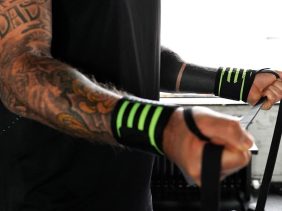Bouldering: How to Rock Climb Without Equipment
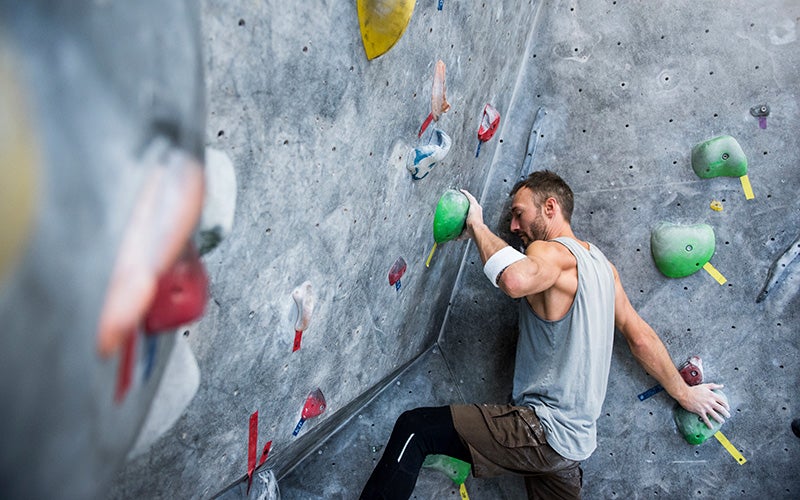 @Canva Images
@Canva Images
Bouldering is a form of rock climbing that is performed at a safe height without any equipment. It’s a full-body sport that requires strength, endurance, and plenty of concentration. Keep reading to find out everything you need to know to get started.
What is bouldering?
Bouldering is a form of rock climbing that’s been around since the 1970s. Unlike other types of rock climbing, bouldering involves absolutely no equipment and is usually performed at a height of 3 to 6 meters to prevent injury in case of falls. It can be practiced both inside and out, whether that be at a gym on steep, artificial walls, or in nature on actual mountainsides.
What is the difference between bouldering and classic rock climbing?
Bouldering is usually performed at lower, more compact heights. The objective isn’t to climb high, but to pass through obstacles like steep walls, angles, and rock overhangs.

Bouldering and rock climbing can both be individual or team sports depending on your preference. The higher up you plan to climb, the better off you’ll be working by yourself, which is why traditional rock climbing is often considered to be better suited to solo athletes. On the other hand, bouldering is thought to be better for teams, as your training partners will be your eyes and ears on the ground and can help you solve obstacles more quickly and efficiently. And because bouldering doesn’t allow for the use of equipment, doing it may require you to be more physically fit as well.
Levels of difficulty in bouldering
Bouldering routes are graded by levels of difficulty. In general, the higher the number or letter, the more difficult the route will be.
Here are the main grades you’ll need to know:
- The traditional UK climbing grades include Moderate (M), Difficult (D), Hard Diff (HD), Very Difficult (VD), Hard Very Difficult (HVD), Severe (S), Hard Severe (HS), Very Severe (VS), Hard Very Severe (HVS) and Extremely Severe, which is split up into three grades of E1, E2, and E3.
- The International Climbing and Mountaineering Foundation (UIAA) grades its routes from 1 to 12, starting with the easiest and ending with the most difficult. Some routes might also use Roman numerals, or include a + or – depending on whether it’s more or less difficult.
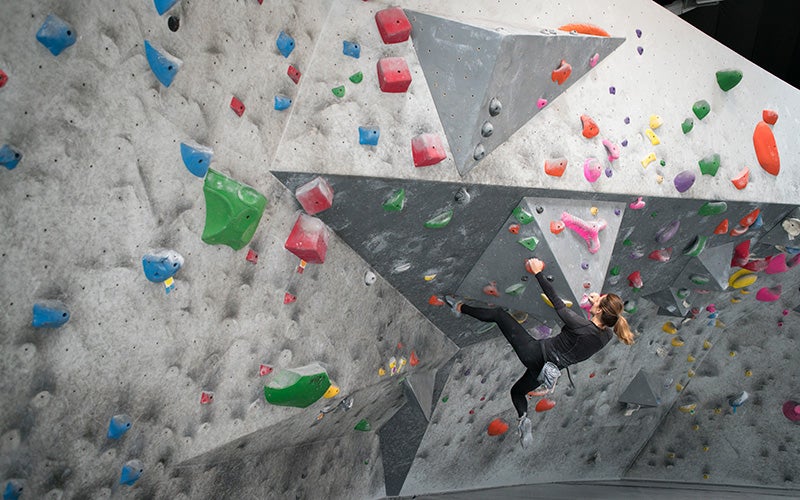
Climbing gyms will usually use colors to distinguish route difficulty and keep you on track.
How risky is bouldering?
Though scaling a mountain without equipment or a spotter may seem dangerous, the risk of injury from bouldering is actually pretty low because you’ll never be more than 4 to 6 meters off the ground. Indoor climbing facilities have the added bonus of being cushioned by soft mats that protect you in the event of a fall.
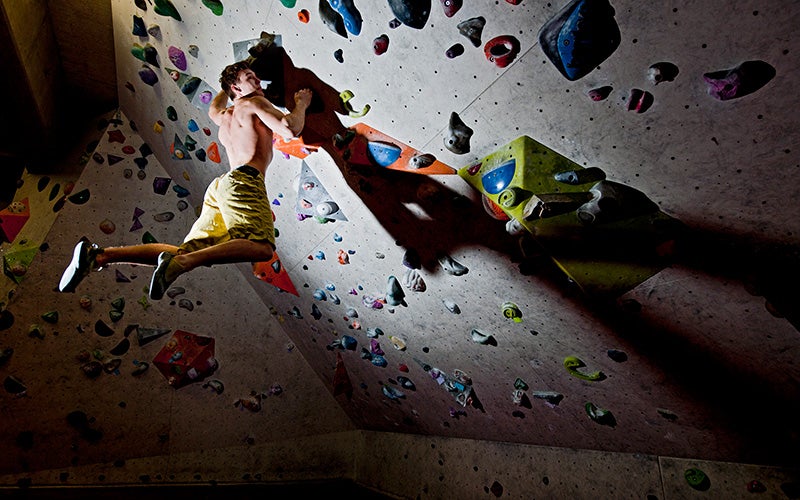
If you’re worried about falling out in nature, it may be in your best interest to use a crash pad. It’s easy to carry around and your climbing partner can be there to make sure you don’t miss it when you fall (because it can be pretty small and hard to spot all on your own). Bandaging your joints before getting started is another good way to prevent them from the shock of any potential falls.
The risk of tendonitis and torn ligaments, especially in the fingers and hands, is higher in bouldering than in standard climbing because of the lack of support from ropes and harnesses. Light scratches and bruises are also inevitable.
As is the case with all other types of sports, it’s important to listen to your body and correctly interpret the signals it’s sending. If you feel pain, that’s probably a sign that it’s time for you to take a break. When it comes to rock climbing, you can never be too careful.
Our tip: Bouldering is an intensive sport that works the whole body and demands the most from the muscles. It’s important to fully recover between sessions to prevent any injuries, and our Recovery Aminos can be just what you need to help speed up the process.
Which muscles does bouldering involve?
Bouldering is a full-body workout. Supporting, grabbing, holding, pulling: Climbing a path activates almost every muscle. Constant movement encourages even distribution of effort over the upper and lower body, making this the ideal workout for training just about everything.

That being said, grip strength is always going to be the primary focus of bouldering. The better it is, the better your overall technique will be. Keep reading to find out more about exercises that can help improve grip, hand, and forearm strength.
Aside from strength, flexibility, and coordination, bouldering also requires immense concentration, both for climbers and their spotters. That’s why it’s also considered to be a great workout for the mind.
Who is bouldering for?
Bouldering is for anyone who wants a physical and mental challenge, and also enjoys exercising with a group. You definitely don’t have to be super buff to rock climb. Even people who are afraid of heights will find that this sport isn’t as intimidating as they might have thought. No matter what your level is, there’s a route for everyone.
One small caveat: People with health problems or previous injuries may want to check in with their doctors before beginning to rock climb.
How and where can I learn bouldering?
If you’re seriously interested in bouldering, it’s best to start by taking a beginner’s class. In the protected environment of a climbing gym, you can learn the proper form and strategies to stay safe as you climb the walls. Experienced instructors will guide you through the proper hand and foot holds so that you’re less likely to make mistakes. Trial sessions and classes are offered in almost all bouldering and climbing gyms.

In general, start your training indoors before venturing into the great wide open where your risk of injury will be inherently greater, especially for beginners. Wait until you’ve developed a bit of experience before taking on a real cliff wall. Once you feel ready to face the rocks, you’ll find that there are plenty of great places to practice wherever in the world you may be. Simply do a quick internet search of the rock climbing sites nearest to you and choose from there.
Equipment and gear
While bouldering doesn’t require the ropes or harnesses used in traditional rock climbing, there are still some basic objects you will need, like the right shoes and a few things to make the climb easier on your hands.
Climbing shoes
Without proper bouldering or climbing shoes, you’ll be completely helpless on the cliffs. Luckily, you can usually rent a pair from climbing gyms if you’re just a beginner. The more advanced you become the more you’ll need a set that’s perfectly suited to your feet and will give you the support you’re looking for.
Chalk

Chalk, or magnesium carbonate, is one of the most important things you can have with you during your climb. By preventing the hands from becoming sweaty, it’ll help you maintain your grip as you climb. Most climbers usually keep it in a small bag that they can clip to their hip for easy access while on the rocks.
Climbing brush
Having a climbing brush is another way to guarantee nothing goes wrong on your climb. Use it to clean holds of debris or roughen them up so they’re easier to grasp.
Crash pad
For climbers who prefer to take their adventures outdoors, having one of these is an absolute must. Having one will greatly reduce the risk of injury in case of any unexpected falls.
Technique and safety
Bouldering is all about form. With the proper form you’ll be able to overcome even the most difficult paths.
Here are the most important techniques to keep in mind:
Rotate your hips to the side
Many beginners tend to let their butt hang down. Climbing in this so-called “frog pose” requires a lot of additional energy. Instead, try to keep your legs straight when facing the wall and rotate your hips inward as you move forwards. Doing this will improve your grip and give your arms and legs more flexibility.
Use the full range of motion of your arms
A lot of beginners contract and bend their arms, which wastes energy and makes it more difficult to climb. Instead, stretch them out as much as possible to engage the full range of motion.
Use your legs
Be sure to also use your legs during a climb. The muscles in your lower body are typically stronger and can handle a lot. Instead of pulling yourself from point A to point B, lean on the wall and activate your thigh muscles. Use your hips to gain momentum and work your way to the next point.
Use trial and error
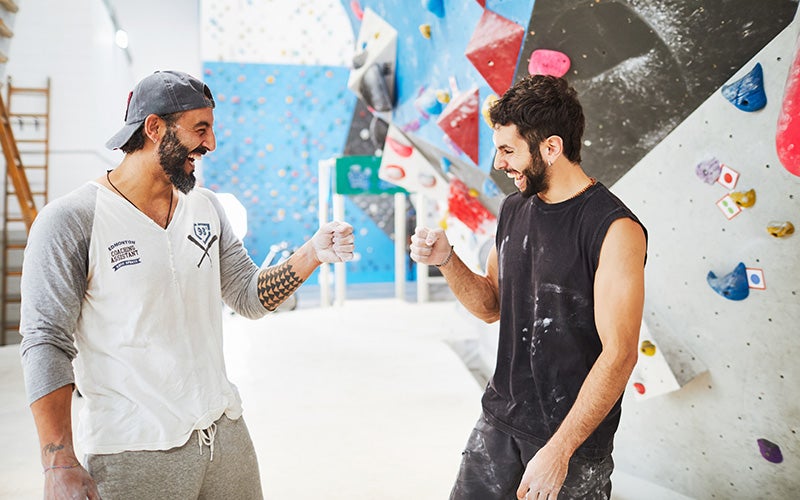
In bouldering, the route is a riddle to be solved. If one way doesn’t work, don’t be afraid to try another. Practice with different hand and foot holds to find the best solution.
Focus
Bouldering is a thinking sport that requires you to stay focused on what you’re doing at all times. Steady concentration is also a great way to protect yourself and your teammates.
In addition to proper form, ensuring safety is of the utmost importance. Here are some of the most valuable safety rules to keep in mind whether you’re climbing indoors or outdoors.
- Warm up: Warming up before a session is key to preventing muscle, joint, and tendon injuries.
- Clear a fall space: Having a clear spot below in case of a fall is the best way to avoid hurting yourself.
- Observe: Non-climbers should always keep an eye on the route and assist fellow climbers in case of a fall.
- Jump safely: Once you’ve completed a route, try to land with your feet together and roll gently to the ground. Always look down before you jump.
- Keep an eye out for kids: Always watch out for children. Parents should also take care to supervise their kids.
Bouldering: Our conclusion
- Bouldering is a style of rock climbing that doesn’t use large accessories like ropes or harnesses. Things like chalk and crash pads may still be necessary.
- Unlike traditional rock climbing, the aim of bouldering is to navigate tricky routes rather than reach high peaks.
- Bouldering can be practiced both indoors at bouldering gyms or up to four meters outdoors on rock faces.
- Bouldering is a workout that requires a lot of physical and mental strength.
- It can also improve coordination, mobility, and concentration abilities.
- Bouldering is all about technique. Beginners should take lessons to learn what and what not to do.
Sources for this article
We at foodspring use only high-quality sources, including peer-reviewed studies, to support the facts within our articles. Read our editorial policy to learn more about how we fact-check and keep our content accurate, reliable, and trustworthy.



























